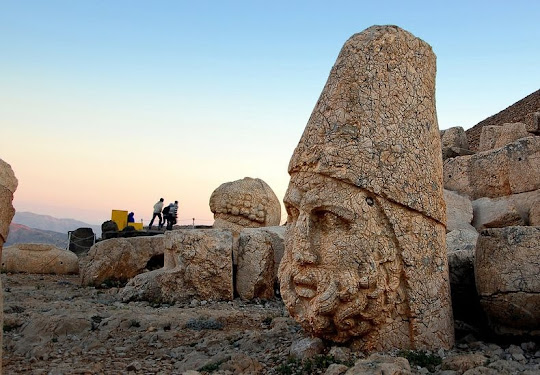The Lakes of Ounianga consist of 18 lakes located in the heart of the Sahara Desert, in an extremely arid region of northern Chad where the average yearly rainfall is no more than 2 mm. They depend on an underground supply of ‘fossil’ water that fell on this area in ancient times when the Saharan climate was much wetter than it is today. Approximately 14,800 to 5,500 years ago the area was occupied by a single large lake, probably tens of kilometers long. As the climate dried out during the subsequent millennia, the lake shrank, and large, wind-driven sand dunes invaded the original depression, dividing it into several smaller basins. The 18 lakes is all that remains today.
The lakes are situated in a shallow basin below sandstone cliffs and hills, from where the ancient water flows. The almost-year-round northeast winds and cloudless skies make for very high evaporation rates. But the underground bed of water-rich rocks are large enough to keep supplying the small lakes with water despite the high evaporation rate. Remarkably, this unique hydrological system is able to sustain the largest permanent freshwater lakes to be found in such an arid desert environment anywhere in the world.

A NASA image taken on November 14, 2009, by the crew of the ISS.
The lakes are divided into two groups, 40km apart. They vary greatly in chemical composition, some being so salty that they can only support the most basic forms of life, while others are fresh enough to provide habitat for aquatic plants, fish and a diversity of other species. The largest and most biologically important lake (Lake Teli, in the eastern group known as Ounianga Serir) has a surface area of 4.4km2 and a maximum depth of 10 m. Its water is fresh, and supports an abundance of life. The sandy substrate is highly porous, so water flows freely underground between Lake Teli and 13 other smaller lakes in the eastern group.
Further west, across the dunes and sandstone ridges that characterise this part of the Sahara, the second group of four lakes (known as Ounianga Kebir) is found, dominated by Lake Yoan (3.6 km2 and 27 m deep). This is a hyper saline lake which supports only algae and a few other micro-organisms. Rocks around its shores are encrusted in white salt deposits, and a sprawling village of some 9,000 people is spread amongst the nearby hills and dunes.
The lakes of Ounianga form as exceptional natural landscape of great beauty with striking colours and shapes. Because of its remote location, only a trickle of fearless tourists (about 500 annually) finds its way to this remote corner of Chad.







Source
READ MORE»
The lakes are situated in a shallow basin below sandstone cliffs and hills, from where the ancient water flows. The almost-year-round northeast winds and cloudless skies make for very high evaporation rates. But the underground bed of water-rich rocks are large enough to keep supplying the small lakes with water despite the high evaporation rate. Remarkably, this unique hydrological system is able to sustain the largest permanent freshwater lakes to be found in such an arid desert environment anywhere in the world.

A NASA image taken on November 14, 2009, by the crew of the ISS.
The lakes are divided into two groups, 40km apart. They vary greatly in chemical composition, some being so salty that they can only support the most basic forms of life, while others are fresh enough to provide habitat for aquatic plants, fish and a diversity of other species. The largest and most biologically important lake (Lake Teli, in the eastern group known as Ounianga Serir) has a surface area of 4.4km2 and a maximum depth of 10 m. Its water is fresh, and supports an abundance of life. The sandy substrate is highly porous, so water flows freely underground between Lake Teli and 13 other smaller lakes in the eastern group.
Further west, across the dunes and sandstone ridges that characterise this part of the Sahara, the second group of four lakes (known as Ounianga Kebir) is found, dominated by Lake Yoan (3.6 km2 and 27 m deep). This is a hyper saline lake which supports only algae and a few other micro-organisms. Rocks around its shores are encrusted in white salt deposits, and a sprawling village of some 9,000 people is spread amongst the nearby hills and dunes.
The lakes of Ounianga form as exceptional natural landscape of great beauty with striking colours and shapes. Because of its remote location, only a trickle of fearless tourists (about 500 annually) finds its way to this remote corner of Chad.







Source

























